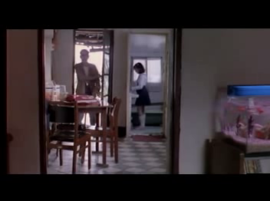Consider two canonical moments in the formation of the developing discourse of cinégraphie and photogénie: Louis Delluc’s “La Beauté au cinema” (1917) and Louis Aragon’s “Du décor” (1918). Long before Bazin’s assessment that ‘pure cinema’ is, in fact, the absence of cinema (on Ladri di Biciclette: ‘No more actors, no more story, no more sets, which is to say that in the perfect aesthetic illusion of reality there is no more cinema’), Delluc ascribed the beauty of cinema to the fact that the medium is ‘rightly moving toward the suppression of art, which reveals something beyond art, that is, life itself.’ He finds such natural beauty-as-truth reflected both in the landscapes of travelogue films and in the presence or présence of the star actor. The metaphor of cinema as a medium of revelation has been amply discussed by Malcolm Turvey, who discovers in it a high degree of skepticism towards the powers of human vision: what the human eye cannot see, or has forgotten to see, is revealed by new optical technologies like the microscope, the telescope, or the camera lens. Delluc too considers it the prime function of the visual arts in general to capture what the human eye cannot (yet) see: ‘Obviously, art would be utterly useless if each of us was capable of appreciating consciously the profound beauty of the passing moment. But the education of a responsive mass of people is going too slowly for us to deprive ourselves yet the many centuries of artworks which ensure the exalted confidence of others’ spirits.’ Richard Abel points out two reasons why the revelatory discourse was so prominent in French film criticism of the late teens: a post-Enlightenment sense of representation as a means to knowledge, obvious from the French fascination with short scientific films, and the centrality of ‘Bergsonism’ and Bergson’s phenomenology of ‘intuition’ to the debates surrounding cinema’s perceived mission of discovering and revealing the ‘world’ or the ‘spirit of things.’ To illustrate the continuing legacy of the revelatory discourse in post-Bazinian French film criticism consider one of its most prominent propagators, Eric Rohmer. In his essay, “Le gout de la beauté” (1984), Rohmer still sounds a lot like Delluc:
Painting, poetry, music, and so forth try to translate truth by the intermediary of beauty, which is their kingdom, and with which they cannot break without ceasing to exist. The cinema, on the contrary, uses techniques which are instruments of reproduction or, one might say, of knowledge. It possess the truth right from the beginning, in a sense, and aims to make beauty its supreme end. A beauty, then, and this is the essential point, which is not its own, but that of nature. A beauty which it has the mission, not of inventing, but of discovering, of capturing like a prey, almost of abstracting from things.
He also sounds like Mallarmé who made an important contribution to the post-Idealist triangulation of nature, truth and beauty central to nineteenth-century aesthetics when wrote in his famous article on Manet from 1876, that ‘the search after truth, peculiar to modern artists…enables them to see Nature and reproduce her, such as she appears to just and pure eyes.’
The spirit of things is also what is revealed in Aragon’s “Sur le décor”, fetishizing over and against the plot, action or narration of an unnamed film (that anticipates the décor of Delluc’s Fièvre):
The door of a bar that swings and on the window the capital letters of unreadable and marvelous words, or the vertiginous, thousand-eyed façade of the thirty-story house, or this rapturous display of tinned goods (what great painter has composed this?), or this encounter with the row of bottles that makes you drunk just to look at it.
As Christian Keathley notes, Aragon’s fetishism must be framed against a specific state of affairs in the early part of the century that André Breton has identified as a ‘fundamental crisis of the object.’ This crisis is what Heidegger locates in a technical orientation he calls Gestell, or ‘enframing,’ a tendency to see objects in the world only in terms of their utility or instrumentality. For the Surrealists, ‘enframing’ could be countered by a radical reframing, reanimating the thing-ness of things by ‘raising them to a realm where they are both commonplace and foreign, banal and perplexing, objects and “things”.’
Reframing can be seen as a way of ‘making strange’, which brings us to another crucial text, published around the time of Aragon and Delluc’s writing, Viktor Shklovsky’s “Art as Technique” (alternatively known as “Art as Device”, 1917). In this essay, Shklovsky posits that art exists in order to disturb the habitualization and automatization of life, speech and perception: ‘Art exists that one may recover the sensation of life; it exists to make one feel things, to make the stone stony.’ But in order to make the stone stony, Shklovsky and Aragon seem to agree, it does not suffice to reveal or uncover it through a process of intuition. First, the stone must be made ‘unfamiliar,’ and this requires a revision of habituated forms of perception.
For the Surrealists, the process of defamiliarizing was on the one hand automatically performed by the photographic apparatus: once some-thing has been captured on film, it is automatically alienated, rendered as an uncanny double of the ‘real’ thing. On the other hand, the Surrealists developed a specific way of looking – fragmentation being one strategy – that further allowed sensuous experience to be recovered. In this regard they share some of Delluc’s Idealism or Romanticism (‘The cinema will make us all comprehend the things of this world as well as force us to recognize ourselves,’ Delluc wrote). For Shklovsky, on the other hand, what art does to make an object unfamiliar is to increase its ‘artfulness.’ Although ‘art is a way of experiencing the artfulness of an object,’ defamiliarization is a technique that ‘is found almost everywhere form is found’ and thus implies a poetics, a form of active making that involves both artist and spectator in a process of creation.
This brings us right back to what Keathley calls one of the top ‘received ideas’ circulating in film studies: the montage/mise en scène debate rendered as the discussion between adding and revealing. Delluc shows that the ambiguity between showing and ‘unveiling’ was already at the heart of the first discussions of the film medium’s specific nature: ‘There,’ he writes about a short travelogue showing the passage of a military convoy of ships in stormy weather,’ that’s beauty, real beauty – I would say the beauty of chance, but the cameraman must be given his due. He has learned how to see with such skill that we have exactly the same experience of the sea, sky, and wind as he himself had.’
I raise this ontological/idealist discussion at the beginning of the theoretization of cinema, because I feel much of what we today refer to as ‘slow cinema’, typified by its ‘hunger’ for reality and the everyday, has been incorrectly framed in almost exclusively phenomenological or, more rigidly, Bazinian terms. In the Anglo-American tradition, the influence of the writings of Stanley Cavell on what he calls ‘the Quest for the Ordinary’ has been key, as evidenced in the writing of William Rothman, George M. Wilson and Andrew Klevan.
In Cavell’s rapprochement between Heidegger and Wittgenstein, the crisis of the object coincides with skepticism and an avoidance of the ordinary: because of a loss of confidence in the modern world and the concurrent rise in the power of subjectivity and the longing for privacy, Cavell argues, we have lost touch with the social world of the ordinary. Although film, ontologically, is a ‘moving image of scepticism’ (we are not present to a film which makes visible a no-longer-existent world), there are certain film stories – like the genre discussed/created by Cavell, the comedy of remarriage – that teach us to acknowledge the obviousness and repetition of the everyday. Klevan starts from Cavell’s identification of film’s capacity to ‘unconceal the obvious’, to disclose the everyday, to celebrate a type of cinema that is based on ‘the routine or repetitive, the apparently banal or mundane, and the uneventful.’ As a starting point, Klevan differentiates his narrative cinema of ‘undramatic achievement’ from the paradigmatic narrative cinema that adheres to an overly dramatic, melodramatic or comic idiom and is ‘structured around either confrontation, or colourful events, or crisis, or periods of significant change.’
Moreover, where classical narrative cinema is expressed in a ‘demonstrative visual style,’ his proffered filmmakers – Bresson, Ozu, Rohmer, early Forman – manage to be visually eloquent without adopting an assertive style. He prefers an un-emphatic, ‘low-key’ style that seems to efface itself the better to ‘reveal’ the ordinary and even warns against a more visually assertive presentation that will ‘transform’ it. Here again we return to Bazinian (or Cavellian) ontological realism and to the paradox at the heart of Delluc’s aesthetics. Steering clear of an oversimplified rendition of Bordwell’s ideas on classical narration, Klevan argues that style should not be equated with ‘stylishness’, with ‘interesting’ visuals motivated by events, crisis etc. Instead, undramatic style reflects ‘the ability of the filmmakers, and not only the director, to provide saliency to the multitude of visual information provided, precisely to put in place the patterns which will guide the viewer’s attention through the significant elements of a work.’
These ‘patterns’ – what he means is mise en scène – alert the viewer to certain objects or general visual content that we might have missed because of their simplicity (like Bazin, he highlights the significance of the objects used in the ‘undramatic’ kitchen scene in Umberto D.). Klevan’s arguing against an overt ‘stylish style’ and plot-orientated mode of narration, his broadening of the concept of authorship (‘and not only the director’), does not neutralize the problematic of artistic agency: no matter how unemphatic the stylistic choices, some human agent still put those objects there, which means they were designed for a particular expressive use. Take the case of Rohmer, discussed at length by Klevan, whose obsession with color-coding every single element in the mise en scène is not exactly unemphatic.
Many of Klevan’s points truck with the characterization of the filmmakers celebrated under the currently fashionable rubric of slow cinema – many of the leading figures of which are discussed in this issue. In my view, most of these filmmakers are interesting less for their rendering of sensuous reality or experiential duration per se than for their stylistic choices, for their tactics of ostranenie. Kiarostami is an example that immediately comes to mind, partly because of the influence of Jean-Luc Nancy’s essay, “L’évidence du film”, in which the philosopher applies Husserl’s phenomenological theory of ‘evidence’ – in Husserl’s own terms, ‘”experiences” in which the respective things and states of affairs are present to me as “they themselves”’ – to posit Kiarostami’s cinema as an art of looking at the world, not of representing but of presenting. Here is echoed Delluc’s characterization of the filmmaker who ‘has learned how to see with such skill that we have exactly the same experience of the sea, sky, and wind as he himself had.’
What Nancy seems to forget because, as Gilberto Perez writes, Kiarostami’s modernism is one that even children can understand, is that his cinema is not only highly self-critical of its own illusions of phenomenological realism (and as Perez notes, it’s even more complicated than that: ‘he may lay bare the constructions of art, but he also employs them in search after truth, and if he lays them bare it is because that way he can better employ them’) but also highly constructed: both narration, structure and film techniques like setting, framing, staging, editing and sound are extremely worked over to achieve the desired effect of what you could describe as a position of ‘engaged distance’. Kiarostami is an artist in Skhlovsky’s sense of having rendered the overly familiar and habitual unfamiliar by presenting it through artistic form. What makes his art particularly interesting, is that the formal strategies he adopts are precisely about reduction (of camera movement, of emphatic framings, of conventional use of music and acting), producing a fascinating dialectic between presence and representation. Deceptively simple, Kiarostami’s films still fulfill Shklovsky’s definition of art as the technique to make things difficult, inviting a prolongation of perception and a sharpening of attention. (On the subject of his film Five, a series of five long takes of natural landscapes captured by a fixed digital camera, Kiarostami mused, ‘If I was going to invent another title for [the film], it would be “Watch again.”’)
Kiarostami’s main acknowledged influence is Robert Bresson, who managed to make strange the most banal, quotidian actions by applying a striking restraint in choices of framing, editing and acting. As David Bordwell has shown, Bresson restricts his camera to a straight-on or a slightly high angle, most typically in medium-shot or medium-close-up range, and he uses only a 50-mm lens. He relies upon eyeline matches and shot/reverse-shot combinations, and his editing can be said to be ‘constructivist’, constructing the action from single shots, withholding an orienting view. Like Ozu and Dreyer, two other filmmakers whose stylistic rigor has often led them to be qualified as ‘transcendental’ filmmakers, Bresson’s austere formal patterning makes him the prime example of a style-centered approach to filmic narration Bordwell has called ‘parametric narration.’ Although Klevan allows for patterning as the one intrusive strategy for the undramatic filmmaker, he immediately characterizes this choice as a narrative one again geared to disclosing ‘apparently innocuous moments or scenes, allow[ing] these patterns to accrue significance across the course of a narrative.’ He is thinking of Ozu here, and so is Bordwell when he characterizes parametric narration as pointing to the abstract patterns – achieved through selection and manipulation of specific cinematic parameters or techniques – the filmmaker imposes upon a causal narrative base.
Klevan has no use for such formalism, for ‘spatial structures’ that are seen as separate from the furthering of the narrative, which in the case of undramatic cinema he associates not with plot-orientated construction but sees as an instance of ‘oblique perspective central to the narration of good films.’ I think that he misunderstands Bordwell, however, when he takes him to task from seeing parametric narration as implying a total separation between style and narrative. Parametric narration is still narration, albeit a type of narration that is distinct from the demands of plot and characterization, with which it may alternate in emphasis. Klevan is thinking of stylistic ‘flourish’, of stylish style as ornamentation, whereas Bordwell is thinking of systematic organization across a film that does not coincide with its narrative economy. He grants that these patterns might be read thematically or symbolically. This is what Klevan does, seeing in Ozu’s use of repetition on the one hand a dedramatizating stance that concurs with the ‘reticent form of family interaction,’ and on the other hand a ‘celebration of routine’ and the comforts of daily life. Yvette Bíro similarly sees Ozu’s use of repetition as evoking ‘an overwhelming sense of permanence’:
Clothing hung on the balcony to dry, an awkward little neon light modestly signaling the excitement of modern life, or the modest furnishings of humble homes do not bespeak the living conditions of the protagonists alone. Instead, their frequent appearance serves the function of accretion: with their quiet persistence things continue to return and to be present to mark the confines of their existence. Independent of them all, life “exists and insists on carrying on”.
Bordwell would argue against this that the themes discovered by Klevan and Bíro are so obvious and banal, so redundant, that to see them as the dominant structuring force of the text is ‘to assimilate the particular to the most general’:
The critic assumes that everything in the film should contribute to meaning. If style is not decoration, it must be motivated compositionally or realistically or, best of all, as narrational commentary. Yet the the error lies in assuming that style and syuzhet [the selection and organization of story events i.e. the construction of the plot] have a fixed relation to one another.
In Klevan and Biró’s approach, Ozu’s cinema is an instance of art-film narration, geared towards creating realism and authorial comment or point of view. By qualifying Ozu as a parametric filmmaker, however, you point to the real interest of his cinema: the alternation in emphasis between film techniques employed for plot construction and film techniques examined for their own stylistic logic.
Although Biró acknowledges the ‘refined play, the subtle significance of uniformity and variegation’ in Ozu, which she likens to tema con variazone in music, she is predisposed to subject this to a more dominant overtone, the Kierkegaardian sublime in the everyday. Bordwell is more inclined to explore the perceived similarity between the filmmaker’s tools of expression and the composer or musician’s. The basis for the parametric style in filmmaking, a trend not tied to any national school, period or genre, he sees in the ‘serialist’ trends in European music of the 1950s. For one, the idea of a ‘parameter’ that Bordwell takes from Noël Burch’s Praxis du Cinéma – Burch who, in structuralist fashion, presented film techniques or stylistic procedures in opposition, or as sets of alternatives – derives from serial music, where it denotes spheres or dimensions like duration, dynamics and timbre to which the idea of serial composition, creating recurring series of ordered elements, can be applied. The composer selects certain parameters to be serialized and then works through the different permutations, creating a new order or structure for the work.
Serialism was adopted in art and architecture during the sixties, but already in the ‘cinéma pur’ movement of the mid to late twenties, especially in a film like Germaine Dulac’s Thème et Variations (1928), based on Messiaen’s piece, you can see the dialectic between spatial-pictorial and rhythmic values at work that was also typical of Mondriaan and Van Doesburg’s work for De Stijl. Music was the art form to which cinema was felt to be closest, with considerations of ‘rhythm’ even overriding the ontological interest amongst early French film theoreticians of the thingness of things. Eric Rohmer has often said that the importance of music to the nouvelle vague filmmakers cannot be overstated. This is somewhat surprising because, like Bresson, Rohmer preferred diegetic sound to non-diegetic music, even mostly shunning the use of music in his films (except, briefly, over the opening or closing credits, as in Kiarostami). So although some of his colleagues in the new wave, notably Godard, punctuated their films with often brusquely interrupted phrases (as in Michel Legrand’s ‘serialist’ score for Vivre sa Vie) and attacks of both jazz and classical, the importance of music must primarily be seen as reflecting an interest in structure.
Again, Rohmer, Godard and Resnais’s interest in serialism, both within a single work and across an expanse of works, was anticipated by Bresson, whose handling of repetition and variation, as Bordwell suggests, becomes especially apparent in the portrayal of ‘insignificant’ routine story actions or trivial linking actions. Where Klevan, in Journal d’un cure de campagne, sees a consciously ‘plain style’ reflecting the day-to-day experiences of the priest, with every stylistic decision read thematically or as an expression of either the character’s or the filmmaker’s point of view, Bordwell finds, in Pickpocket, a much more ‘rich play of syuzhet and style in the narrational activity of the film.’ One example he discusses is the sense we get of the characters moving to fulfill a preordained decoupage: one step making a ‘just noticeable’ compositional difference. Another is the reiteration of camera setups: each time Michel visits his mother’s apartment, the same camera movement follows his route. To repeat: although thematic interpretation of these repetitions is made available, it also carries little saliency in itself. Bordwell therefore prefers to see Pickpocket as expressing ‘stubborn resistance to interpretation, preferring ‘order over meaning,’ that is ‘closer to music than to the novel.’
The influence of Bresson, through Godard and much of the Nouvelle Vague, where it collided in endlessly productive ways with Rosselinian phenomenological realism, Eisensteinian constructivism and Brechtian Verfremdung, in the late sixties ran up against the influence of an American cinematic avant-garde that, in its thematization of the very means of cinema, can be seen as harking back to the ambitions of ‘cinéma pur’: the ‘structural cinema’ of Hollis Frampton, Michael Snow and Ernie Gehr was defined by P. Adams Sitney as ‘a cinema of structure in which the shape of the whole film is predetermined and simplified, and it is that shape which is the primal impression of the film.’ Structural cinema is the outcome of the divorce between style and narrative that Klevan attributes to parametricism. The film is organized by a non-narrative system: Snow’s Wavelength (1967) is a forty-five minute forward zoom; his La Région centrale (1971) is an exploration of a barren plateau in which, per Sitney’s techno-poetic evocation, ‘the camera sweeps in 360° circles, explores in expanding or contracting spirals, and crosses in zig-zagging pans, focusing on the ground around its base in flowing close-ups and the distant horizon in zooming telephoto shots’; Gehr’s Serene Velocity (1970) alternates shots of an empty corridor in which only the focal length of the lens changes; Frampton’s Zorns Lemma (1970) ‘takes its title from set theory, where it seems that “every partially ordered set contains a maximal fully ordered subset.”’
The formal explorations of structural film were taken up by a filmmaker like Chantal Akerman who, while initially most inspired by her residency at Anthology Film Archives, in her narrative films started to explore a possible rapprochement between structural and Bressonian-Godardian spheres of influence. The result can be seen in Akerman’s films from the mid to late seventies. In Je, tu, il, elle (1974), for instance, she rhymes a minimalist narrative about Bressonian loneliness and (sexual) estrangement with a systematic exploration of interior space.
The influence of structural cinema, amongst which Sitney includes Warhol, can be seen in many examples of slow cinema. Kiarostami’s Five is clearly a Structural-Warholian experiment in fixed-frame observation (there’s quite a lot of Larry Gottheim and James Benning too in the ‘just-noticeable’ changes in uninterrupted takes that capture the movement of sea, sun, moon, clouds, and the animate or inanimate objects they affect): the filmmaker’s confession, in the making-of Five on Five, that he just turned the camera on and then went to sleep, echoes Warhol’s professed indifference to directing, framing or lighting (per Sitney: ‘He just turned the camera on and went away’). Nevertheless, and despite the increasing importance of playfulness, numeric-serial organization, and structural exploration of the parameters of cinema (mostly editing and sound from Taste of Cherry onwards), in Kiarostami’s cinema, Five was generally received as another exercise in Bazinian realness. The filmmaker further complicated the reception of his film by presenting it as an homage to Ozu, the film’s full title reading, Five Dedicated to Ozu. Why would Kiarostami dedicate his film to Ozu? On this subject, Kiarostami says only, in Bazinian terms, that he treasures Ozu’s long shots and the overall simplicity of mise en scène for the respect they express towards the audience. It is unclear whether Kiarostami (or the translator) is referring to shot size or shot length, but what we should take away is the stress on the ‘sparseness’ of style that refuses certain options (like camera movement) to better highlight pattern-making. One of Kiarostami’s preferred aesthetic forms is the haiku, which is both extremely simple in appearance but highly ordered, patterned and seriated. Donald Richie reports that Critic Nagai Tatsuo once asked Ozu if his seasonal titles meant he was interested in haiku. Ozu replied that he wrote maybe three haiku a year, but, in truth, Richie says, his journals are filled with them.
The ‘delayed’ influence of Ozu is often held to be the reason for a the rise to prominence of a new type of Asian art cinema in the early 1990s, that present a narrative geared to the exploration of everydayness in a style that austerely adheres to self-imposed strictures in terms of editing, camera movement, shot length and the use of non-diegetic music. In terms of plot, these films belonging to a stream Bordwell classifies – with reservations about the terminology – as ‘Asian minimalism,’ closely following the schema of Klevan’s undramatic cinema:
The prototype is now familiar. The story traces the lives of relatively few characters, with a focus on mundane activities. In place of the earth-shattering conflicts we see in more mainstream entertainments, these films present everyday and intimate human dramas, often embedded in routine activities – riding a train or bus, walking through a neighborhood, eating and drinking with friends and family. While the situations may recall the problems of love and duty we associate with melodrama, the characters tend not to burst into grand emotional displays. Instead, their feelings tend to be muted or stifled, repressed rather than expressed. In plot, this strain of Asian cinema tends not to present the goal-oriented, problem/solution dramatic arc to be found in mainstream entertainment. Instead, we get episodic plot structures, which favor the loose accumulation of scenes. Characters’ backgrounds may be left sketchy, and information about their pasts might never be revealed. Important action may take place between scenes, creating gaps in our knowledge about how the story is unfolding. We may be left with some uncertainties about why characters do what they do or what the outcome of their actions will be.
Essentially, these qualities don’t differ much from the story action of Neorealist films, with their elliptical, episodic and often unmotivated or open-ended narratives. The difference is in the austerity of the style which, in combination with the mundane story and loosely structured plot, ‘obliges us to concentrate on details of behavior that might reveal what is going on below the surface of the action… The approach obliges us to focus on details, to register slight changes in characters’ behavior, and to keep thinking about why we are seeing the story in this way.’ It is precisely in the stylistic handling of the suyzhet that this new cinema can be said to adhere not only to the principles of phenomenological realism attributed by Bazin and Ayfre to Italian Neorealism, but to the systematic exploration of parametric elements that typifies the style of otherwise quite dissimilar filmmakers like Bresson, Ozu, Dreyer, Tati, Godard, Fassbinder, Akerman and, in the repetition, variation and structural jokes of Three Resurrected Drunkards (1968), Oshima.
Take a filmmaker like Tsai Ming-liang, who in his exploration of interior spaces resembles seventies Akerman quite closely, only with added laughs. In What Time Is It There? (2001) the death of Hsiao Kang’s father leads to a typical bit of stone-faced comedy when mother becomes convinced that her husband has been reincarnated as a fish (the joke is a reference to Imamura’s The Pornographers, in which the landlady Haru believes that her husband, reincarnated as a carp, disapproves of her relationship with a maker of pornographic films). Tsai gives us the living room space where mother has set up a shrine to her dead husband from a variety of angles, without repeating the same perspective, but always putting the fish tank in our sightline. At the level of plot the time lag designates the mother’s incrasingly unstable state of mind, but the real joke is hidden in the permutation of the same stage-like living space.
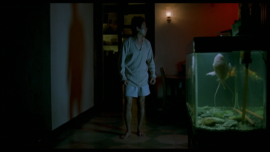
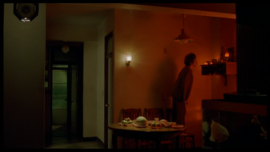
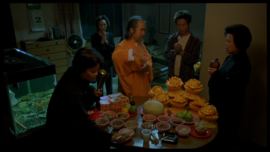
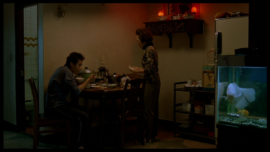
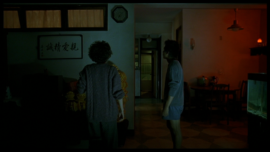
The carp is Imamura’s but the joke with the funny fishtank framing may be Hou’s; compare the framings in Tsai to these from Daughter of the Nile (1987).
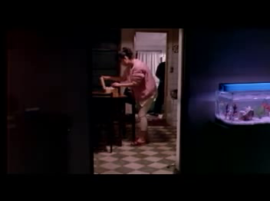
In an interesting article in Cinema Scope, Blake Williams compares the Tsai ‘Late Digital Period’ with the work of structural filmmakers like Gehr and Benning, whose own embrace of digital technology has led to an increase in shot length and a further sparsening of style, a reduction of expressive possibilities. Warning against a complete identification of Tsai’s cinema, which is essentially still narrative, with that of the structuralist avant-garde, Williams also notes that it is incorrect to automatically attach to the Taiwanese filmmaker’s interest in natural rhythms and contemplation Bazinian conceptions of ‘realness.’ Rather, he sees both Tsai and filmmakers like Gehr and Benning as working towards ‘an active mode of attentiveness’: ‘Attentiveness…is a viewing (and listening) stance that demands patience and participation. It involves staying close to filmic detail and nuance, observing not just from the sidelines, but from a place of proximity.’ Rather than align Tsai’s work with Brecht’s conception of alienation, exploring the limits of narrative engagement and testing the viewer’s endurance through extremely extended static long takes in which nothing happens but the smallest physical gesture (or gestus), its appeal for closer engagement, in my view, is better understood as taking shape in Shklovskian terms as active strategies for making strange.
In Apichatpong Weerasethakul’s films, one of the recurring estranging devices is that of ‘beginning again’, of dividing the film in two or more parts that are given as variations on a theme, enabling a much stronger imbrication of narrative and structural exploration. The diadic structure of Syndromes and a Century (2006) is perhaps the most elaborate illustration of this principle. After the movie’s first half, set in a hospital in rural Thailand, ends with the disappearance of one its main characters, last seen wandering off into the night, as in Apichatpong’s previous film, Tropical Malady (2004), the filmmaker reboots the opening scene in a more contemporary setting in Bangkok medical center. Playfully recapturing, with slight variation, the blocking, framing and editing of the first half, Apichatpong clearly sets up a thematic ‘reading’ of the reiterated circumstances between past and present (what has been lost in the decalage?).
At the same time, the pleasure he derives from these minute variations, comparable qua stylistic execution to his games with ninety or one-eighty degree ‘compass point’ editing (exemplified by these shots from Blissfully Yours 2002), a favored device of Asian minimalism, is not necessarily motivated by plot and draws attention to itself as a kind of palindrome.
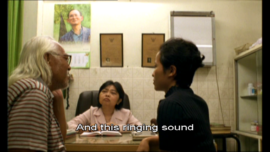
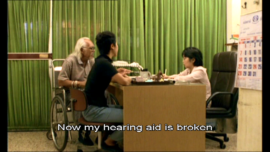
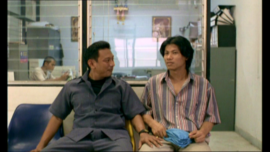
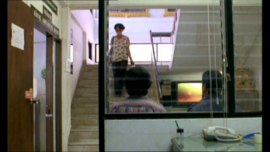
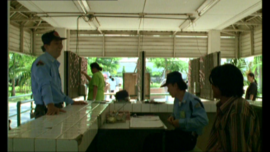
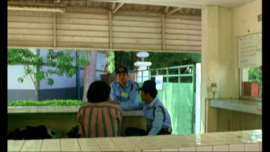
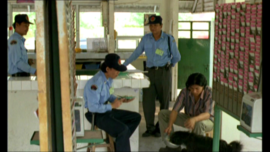
Given that these serial reiterations are not only film-specific but are continued throughout a series of films or even throughout the entirety of the filmmaker’s ‘works’ (a man that disappears chasing after a stolen motorcycle in Bissfully Yours is the dead man found by the police in the opening scene of Tropical Malady), you can say about Apichatpong what Jean Ma observes about Tsai: ‘Since the release of What Time Is It There, Tsai’s films appear less as self-contained individual units than as a series of variations and extensions of a single fluctuating, porous, and hybrid meta-fiction.’
Similarly, although as closely associated with a dedramatized and satirical style of laconic everydayness as Tsai, South-Korean filmmaker Hong Sang-soo’s films are characterized by a high degree of formal rigor organized around the idea of theme and variation. His recent In Another Country (2012) is but the most explicitly literary example of Hong’s tendency to structure his plots around different versions of the same central event: a bored young woman decides to write a screenplay in a seaside town that uses that town for the location. She comes up with three variations all starting from the same premise of a French visitor named Anne (played by Isabelle Huppert) visiting the resort. Situations reoccur (like the goofy lifeguard trying to seduce Anne, the borrowing of an umbrella, or Anne trying to find the town’s lighthouse) but although they adhere to the same general pattern there is always a slight difference, as illustrated by the almost-identical framings that are scattered throughout the film. David Bordwell has pointed out that one of the pleasures of a Hong Sang-soo film is that it tests our memory of earlier scenes’ action: ‘Few filmmakers can make audiences laugh at the mere appearance of a shot and tease us to expect a replay of or departure from what we’ve already seen.’
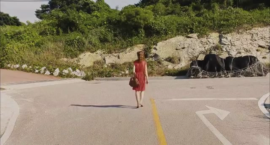
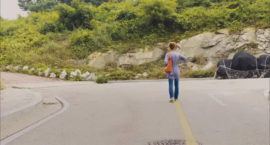
Even more than Hou, Hong fits the bill of the variational everyday that Biró sees in Ozu’s films: ‘Scenes of the customary gathering of his characters, their innocent fun and games, the moderate or excessive bouts of drinking sake are all familiar yet always somewhat different. On the second encounter or somewhat later one recognizes previously seen takes.’ Like Tsai, Hong is extremely fond of the nouvelle vague filmmakers and takes from them both the dictum of their old mentor Jean Renoir that an auteur is someone who always makes the same film and their playful engagement with patterns, structures and series. Also borrowed from the nouvelle vague is the practice to work with a small group of actors frequently cast in the same type of role and in typical situations that occur in film after film. The names of these characters are also extremely similar from one movie to the next, without the fit between name and character or type of character being in any way consistent.
As in Apichatpong, parallels, patterns and motifs occur not only intra-filmically but are developed through a series of films, (re)turning Bordwell’s observation about the pleasure of recognition into a condition of auteurism. There’s very strong continuity, for example, between the stories and characters of Oki’s Movie (2010), Nobody’s Daughter Haewon (2013) and Our Sunhi (2013), without these films being in any way tagged as sequels: all centre on a collegian love triangle between an older professor, his one-time protégé (or protégée) and a fellow student. Oki’s Movie fronts Hong’s play with temporality and point of view: the movie is divided into four chapters, showing different stages of the relationship from different perspectives, the chronological order of which is not always easy to discern. In the final chapter, also titled “Oki’s Movie”, a short film made and narrated by the female character sets up a precise comparison between the ‘older man’ and the ‘younger man’ by minutely calibrating similarities and differences between a series of winter walks. While the diaristic narration and embedded dream sequences of Nobody’s Daughter Haewon makes it typical of Hong’s ‘modernism’, the parallelism and crisscrossing storylines of Our Sunhi seem to fit in more closely with the mechanistic world of farce and its coincidences, narrowly avoided encounters, awkward convergences and circulating talismanic objects (in this case the comments about Sunhi taken from a professor’s letter of recommendation). ‘People tell me that I make films about reality,’ Hong has remarked. ‘They’re wrong. I make films based on structures that I have thought up.’
In conclusion of what risks to become a prime example of the reiteration of the same point, I will take a closer look at the cinema of Hou Hsiao-hsien, who is generally considered to be one of the most important filmmakers of Asian minimalism, and whose influence has been acknowledged by Kore-eda and Jia Zhang-ke among many others. Much ink has spilled about Hou’s relationship to Ozu, an influence first denied then finally embraced by Hou, that came to the fore when he was invited by Ozu’s studio Shochiku to shoot a film in Tokyo in Ozu’s style commemorating the anniversary of the iconic filmmaker’s death. I will look at Café Lumière (2003) because it obviously allows for the closest comparison to Ozu’s parametric style, without suggesting that the film offers anything profoundly new in Hou’s work (the Taiwanese title translates as “Coffee Time,” highlighting the fact that about a third of the scenes feature or are constructed around eating and drinking, including those most dramatically salient, a constant with Hou). Despite a perhaps increasing self-awareness in his work, reflected for instance in the pastiche of all of the ‘phases’ in his work in Three Times (2005), Hou, like Ozu, has remained remarkably consistent (a critic like James Udden makes much about Hou abandoning his relatively static framings in favor of a constantly roaming and searching camera, but other than in some aspects of composition, I don’t think this move has had much impact on his basic formal system), attempting a balancing act between historical inquiry and close humanistic engagement with character on the one hand with a reflection on the parameters of his own, consciously ‘sparse’ cinema on the other.
It’s difficult to ascertain where Hou’s interest in cinematic form came from. Despite his short stint at the Taiwan Academy of Arts, Hou is essentially an autodidact, if not exactly a cinephile like Edward Yang, his friend and colleague in the Taiwanese New Wave, one who discovered the principles of cinema, of his own cinema, by following through on seemingly naive questions about point of view. Several great filmmakers have reduced their art to a number of seemingly simple questions or choices: for Godard the main question in cinema used to be when to end a take, while for Ford cinema has always been a matter of where to put the camera. For Ford, this is not something you can learn. Hou, however, tried to pick up as much as he could from Yang about, for instance, the difference between the filmmaker’s point of view and that of the character. Hou’s natural inclination in this period of apprenticeship was to be as humble as possible, striving for an objective unveiling of everyday reality and telling his cameraman to ‘pull back pull back!’
Such self-effacement, however, inevitably leads the filmmaker to reflect back on the range of stylistic possibilities at his disposal and their expressive connotations. The more he started to ‘pull back!’, the more objective he wanted to become, the more he became aware of the expressive possibilities of film’s parameters. From the time of A Time to Live, a Time to Die and City of Sadness and Hou’s variation on the Satyajit Ray-Ford-Visconti family saga, he started elaborating upon the pretty conventional idea that you can call up transience and loss by repeating a setting and framing associated with a particular character and then emptying the frame. In A Time To Live, the recurring image of the father at his desk becomes a memento mori; inversely, a reiterated, equally distant, framing of the middle son washing up, follows his maturation from child to adolescent.
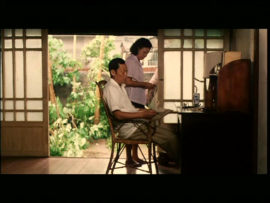
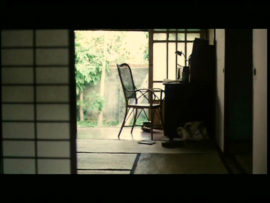
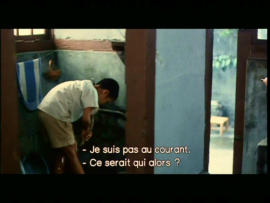
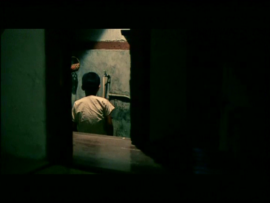
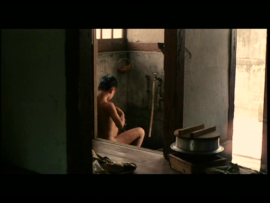
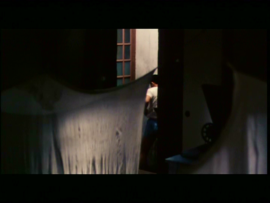
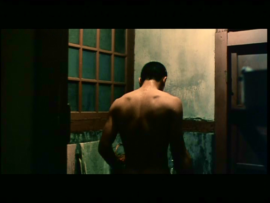
As Hou becomes more self-conscious about his choices and his own importance as a filmmaker, we can see how such stylistic patterning exceeds its primary function of making salient the films’ consistent theme of tradition and change and starts to play out according to its own internal logic.
If we discount the mobile locations of subway and train cars that feature prominently, there are three settings in Café Lumière that we encounter more than once: Hajime’s second-hand bookstore, the café Erica, and Yoko’s apartment. The apartment is the first location we see in the movie: after a brief pre-titles ‘transitional’ shot of a passing train – its stressed diagonal recalling Ozu – we are introduced to our main character, a young girl living in Tokyo. The leisurely way exposition is set up in this opening scene, is typical of both Hou and Ozu: important plot points are indirectly and elliptically recounted and placed digressively at the same level as details of everyday behavior. The scene is a long take, shot out onto the window and balcony, the only visible source of light, and framed well-nigh straight-on as a medium-long shot.

Despite the clutter, the frame is well-balanced, an impression enforced by the fixed camera position. The few times the camera moves, it pans and tilts with Yoko’s movements (she twice ducks to the space left of the frame, first to pick up the phone then to get a present for her neighbor who is at the door).
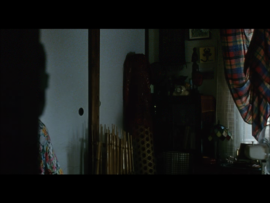
Strikingly, after these reframing movements the camera is always maneuvered back to its initial position. Even more noticeable is that this mostly happens incrementally, the camera making barely perceptible adjustments before moving back to its place. I want to cast the camera’s hesitation between stasis and motion as part of the formal system that Hou sets up in this opening scene. This system suggests a revision of the strict adherence between chosen framing and repeated setting or locale that is perhaps the primary logic of patterning in Hou’s movies.
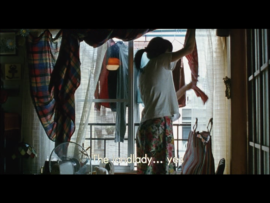
When we return to Yoko’s domestic space much later in the movie (apartment scene 2, AS 2), it seems Hou not only want us to notice the similarity in framing but also that the camera’s place has changed, that a permutation has been initiated. After an insert shot of pages in a book Yoko is reading aloud, Maurice Sendak’s children’s book Outside Over There providing an important motif, there is a cut (just as Yoko reads ‘outside over there’) to a medium shot that shows her sitting at a low table.
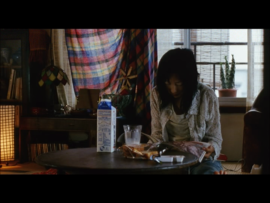
If we study the new layout carefully, we notice that not only has the camera been placed closer compared to AS 1, it has also been lowered and angled more to a three-quarter view. But most importantly, it has been moved slightly to the left, which, combined with the angle, gives us a view of a part of the apartment we had caught only fleetingly in the first scene (when Yoko was reaching for the phone and the neighbour’s present). Although camera movement is still primarily tied to the actor’s movements (panning up when Yoko gets up to close a window), an unmotivated lateral movement is initiated at the start of the shot, that proceeds so carefully that it is all but imperceptible to the casual viewer (the gradual revelation of right side of the doorway behind which the camera is positioned, allows us to track the change in our field of vision). This extremely gradual and subtle shift back to the right side of the space, familiar from AS 1, is another indication that Hou wants us to notice the changes between the two scenes.
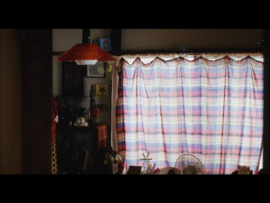
The apartment is further explored when we return for a third visit (AS 3). The most obvious difference is that this scene starts on an empty frame. The camera is still angled somewhat to the left, although the overall orientation stays on the window, that is now draped with the tartan shawl that was seen hanging loose earlier. Camera height has been altered again, a higher position than in AS 1 revealing a red hanging lamp. Relative to both AS 1 and AS 2, the camera is placed further to the left, now revealing the left border of the doorway to an adjacent room. As in AS 1 and AS 2, the camera is clearly positioned outside this doorway, creating frame borders on the right (AS 1), left (AS 2) and, eventually, on both sides (AS 3). Camera movement does not seem as focused on figure movement, although there is a tilt down with Yoko as she stores milk and some unseen groceries in the fridge. In fact, the camera seems uncertain where to go, panning left and right, tilting up and down, and by its movement variegating between the different set-ups we have seen so far. Oddly, even before it starts to pan, the camera seems to be gently swaying, moving rhythmically to the accompaniment of piano music (by modernist composer Jiang Wen-Ye, the topic of Yoko’s dissertation, reinforcing the link between Hou’s stylistic variations and serial music) that has bled over from the previous scene. All these instances are minimal, hardly noticeable when you’re not paying attention.
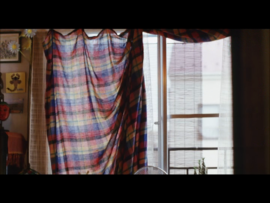
Our fourth view of the apartment (AS 4) comes after a jump cut from AS 3, the discontinuity somewhat disguised by the sound of a ringing phone. As in AS 3, we start on an empty frame. Although the angle of view is again essentially the same as in the previous scenes, the camera has now been angled slightly to the right. The camera height is lower than in AS 3, much higher than in AS 3 and slightly higher than in AS 1. The distance of the camera is the closest it has been, its position slightly to the right of AS 2 and AS 3, but still to the left of AS 1. The camera continues to sway, and when there is a reframing movement (pan and tilt) to Yoko sitting down at the low table to go through her mail, the framing becomes quasi identical to that of AS 2, albeit with the camera a little higher. When Yoko walks offscreen, the camera tilts back up to approximately its initial position.
There will be more of Yoko’s apartment to explore, but we have enough to trace a pattern that Hou has created by variegating the angles and camera positions. This pattern can be schematized as follows, with AS 1 providing the base values:
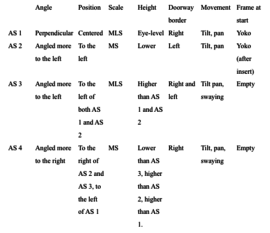
The permutations Hou has introduced are of a purely formal artistic nature, bringing into play the variables that are operative within the self-imposed constrictions of his sparse style: like Ozu, Hou eschews conventional patterns of classical continuity to explore the changes brought about by minute shifts between a restricted number of variables, in this case primarily those related to camera movement and camera placement. Although several critics have remarked upon the intricate structure of Hou’s films relying on repeated locales and iterated compositions, most have passed over the minute differences between two similar sets of framings. James Udden, for instance, notices the large numbers of scenes set in the hospital corridor in City of Sadness, all framed along the same axis, but ties this pattern of repetition to Biró’s thematic notion of historical change. What he fails to note is that few of these framings are exactly identical, but suggest a series of minute shifts that perhaps is more visible from the reiterated framings of the Lin restaurant in the same movie (take the table in the foreground space of the shot as orientation point to get a sense of these minute shifts – mostly related to shot size – that are anything but haphazard).
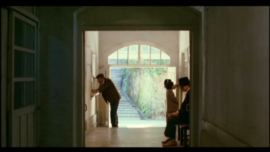
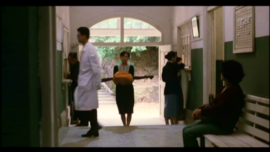
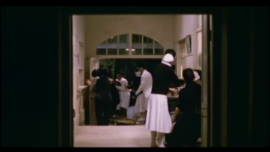
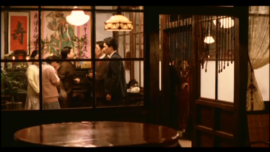
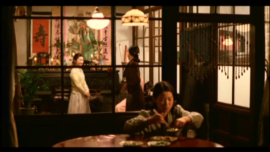
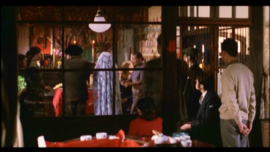
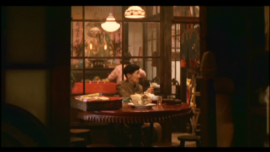
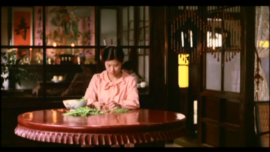
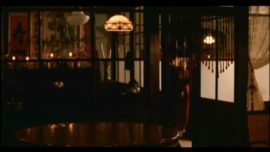
It’s true that these shifts invite any reading that fits the cyclical pattern of transience or historical change. But this thematic is so readily available, cued by so many other elements in the film’s narration, that the filmmaker’s attention seems focused more on the permutational exploration of film form, to macro-structural patterns and symmetries that although still pertaining to a causal narrative base, exceed their narrative function and self-consciously reflect on the film’s stylistic organization. Like Ozu, Hou gives us spatial cues or ‘anchors’ to analyze the space: one way to read the minute shifts in spatial representation is to focus attention on the cluttered props – the electric fan, the stuffed toy, the art nouveau table lamp, the bookcase – that maintain their relative position from shot to shot. More than the duration of the single shot, more than its mise en scène or (often self-consciously static) framing, it is the pattern established throughout the work, the repetition and variation of almost-identical shots that invites the viewer to scan the frame, to pay close attention to what the (often playful) application of the filmmaker’s craft has made us see.
